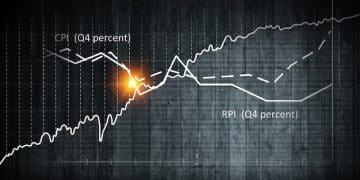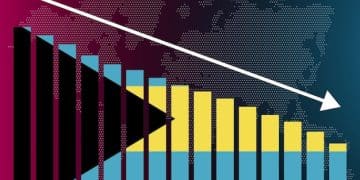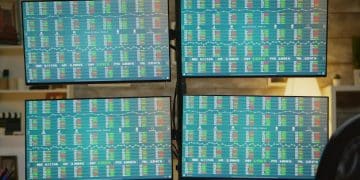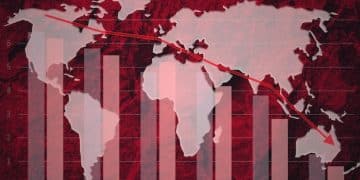Federal Reserve Policy & 2025 Inflation Projections: A Deep Dive
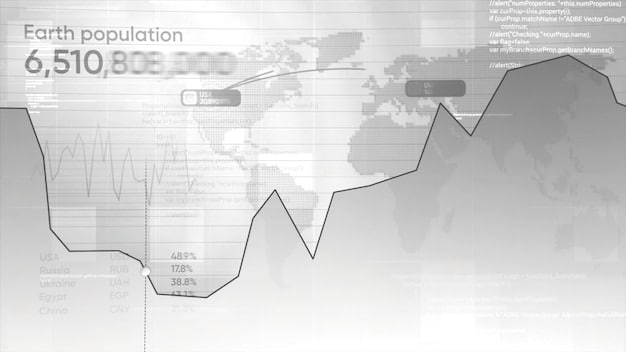
The Federal Reserve’s recent policy adjustments are poised to significantly influence the United States’ economic landscape, with their impact on 2025 inflation projections being a central concern for policymakers, businesses, and consumers alike.
The economic world is abuzz with the latest pronouncements from the Federal Reserve. Their recent policy changes are not just technical adjustments; they represent a strategic shift with far-reaching implications, particularly for future economic stability. Understanding the Federal Reserve Policy Impact on 2025 Inflation Projections is crucial for anyone navigating the intricate currents of the modern economy, from market analysts to everyday consumers.
Understanding the Federal Reserve’s Mandate and Recent Shifts
The Federal Reserve, often simply called “the Fed,” operates with a dual mandate: to achieve maximum employment and maintain price stability. These two objectives, while seemingly distinct, are intrinsically linked and often present complex trade-offs for policymakers. Recent inflationary pressures, stemming from a confluence of global supply chain disruptions, robust consumer demand, and geopolitical events, have intensified the Fed’s focus on its price stability objective. The new policy framework reflects an evolving strategy to address these challenges while attempting to navigate a soft landing for the economy, avoiding a significant downturn.
Historically, the Fed relied heavily on the federal funds rate as its primary tool for influencing economic activity. By adjusting this benchmark interest rate, they could either stimulate or cool down the economy. However, the current environment demands a more nuanced approach. The recent policy shifts encompass not only adjustments to interest rates but also a reconsideration of the pace and scope of quantitative tightening, alongside enhanced forward guidance designed to manage market expectations. These combined measures aim to exert a more precise control over liquidity and borrowing costs across the economy, with the ultimate goal of moderating inflation without stifling growth. The challenge lies in calibrating these tools to strike the right balance, a task made even more complex by the inherent lags in monetary policy transmission.
The Dual Mandate: Balancing Act for the Fed
- Maximum Employment: Aiming for the lowest sustainable unemployment rate, where everyone who wants a job can find one without triggering excessive inflation.
- Price Stability: Keeping inflation at a manageable and predictable level, typically targeted around 2% over the long run, to preserve purchasing power.
Quantitative Tightening (QT) and Its Role
Quantitative Tightening (QT) involves the Fed reducing the size of its balance sheet by allowing maturing bonds to roll off without reinvestment, or actively selling assets. This process withdraws liquidity from the financial system, effectively tightening financial conditions. While less direct than interest rate hikes, QT can significantly impact long-term interest rates and the availability of credit. The recent policy indicates a sustained commitment to QT, signaling the Fed’s resolve to shrink its balance sheet to a more normalized level, thereby reinforcing its efforts to combat inflation.
The evolving economic landscape, marked by persistent global uncertainties and shifts in labor market dynamics, has forced the Fed to recalibrate its approach. Their new policy pronouncements signal a recognition that the previous operational frameworks may not be entirely suited for the challenges of today. This adaptability is critical; however, it also introduces an element of uncertainty for markets and businesses trying to project future economic conditions. The success of these new policies will largely depend on their implementation, the market’s reaction, and unforeseen external shocks.
Key Components of the New Federal Reserve Policy
The Federal Reserve’s recent policy announcement is multifaceted, moving beyond simple interest rate adjustments to encompass a broader strategy. At its core, the new policy framework centers on a dynamic approach to monetary tightening, combining traditional and non-traditional tools to achieve its economic objectives. This includes not just the widely anticipated adjustments to the federal funds rate, but also subtle yet significant shifts in its balance sheet management and communication strategies.
A pivotal element of this new policy is the continued emphasis on data dependency. The Fed has repeatedly stressed that its future actions will be heavily influenced by incoming economic data, particularly inflation readings, labor market indicators, and global economic developments. This iterative approach allows for flexibility but also introduces a degree of unpredictability that market participants must factor into their projections. Furthermore, the Fed has refined its forward guidance, aiming to provide clearer signals about its intentions without committing to rigid future paths, acknowledging the fluidity of economic conditions. This balance between clarity and flexibility is a delicate act, crucial for managing expectations.
Rate Hikes: A Sustained Trajectory
- Gradual Increases: The Fed has indicated a trajectory of measured interest rate increases, calibrated to economic data.
- Inflation Targeting: Aggressive hikes aim to bring inflation down to the 2% target, but with an eye on employment.
- Market Expectations: Managing financial market expectations is critical to ensure smooth transmission of policy.

Beyond the interest rate decisions, the Fed’s stance on its balance sheet remains a critical component. The ongoing process of quantitative tightening (QT) is designed to systematically reduce the sheer volume of assets held by the central bank, thereby absorbing excess liquidity from the financial system. This reduction in the money supply is a powerful, though often less understood, tool for combating inflation. The new policy outlines a more defined pace for QT, signaling a prolonged effort to normalize the balance sheet size, which has implications for long-term bond yields and the overall cost of capital.
Moreover, the Fed seems to be adopting a more cautious and communicated approach to its policy changes. This increased transparency, while at times leading to market volatility as new information is digested, ultimately aims to reduce uncertainty over the longer horizon. By explicitly detailing the rationale behind its decisions and offering insights into its economic outlook, the Fed seeks to anchor inflation expectations more firmly. The success of this new policy framework hinges on its ability to effectively influence borrowing costs, consumer spending, and business investment, all converging to achieve price stability.
Analyzing Current Inflationary Pressures and Their Drivers
Understanding the current inflationary environment is paramount to assessing the potential impact of the Federal Reserve’s new policies. The recent surge in inflation is not a monolithic phenomenon; it is driven by a complex interplay of demand-side pressures, supply-side constraints, and external shocks. Disaggregating these drivers is essential for forming accurate projections and evaluating the efficacy of monetary policy interventions. The persistence of high inflation has caught many off guard, challenging long-held assumptions about the transitory nature of price increases.
On the demand side, robust consumer spending, fueled by accumulated savings during the pandemic and a strong labor market, has played a significant role. This pent-up demand, particularly for goods, overwhelmed supply chains that were already struggling with pandemic-related disruptions. Fiscal stimulus measures also provided a substantial boost to aggregate demand, further exacerbating inflationary pressures. However, the picture is not solely one of overheating demand. Supply-side bottlenecks, including labor shortages, semiconductor scarcities, and logistical challenges, have severely constrained the ability of producers to meet this heightened demand, leading to price increases across various sectors.
Supply-Side Constraints: Bottlenecks and Shortages
- Global Supply Chains: Ongoing disruptions from geopolitical events, regional lockdowns, and shipping delays.
- Labor Shortages: Affecting manufacturing, services, and logistics, leading to higher wage demands and production costs.
- Energy Prices: Volatility in global energy markets impacting transportation and production costs across industries.
Beyond these immediate factors, structural shifts and external events have also contributed to the inflationary landscape. The Russian invasion of Ukraine, for instance, sent shockwaves through global energy and commodity markets, driving up prices for oil, natural gas, and various agricultural products. Moreover, the transition to a more localized, resilient supply chain strategy post-pandemic could inherently lead to higher production costs compared to highly optimized, globally diversified systems. This “onshoring” or “friend-shoring” might offer security but comes with a price tag, potentially embedding a degree of inflation for the foreseeable future. The challenge for the Fed is to differentiate between these various drivers and target those that are most responsive to monetary policy, avoiding over-tightening where supply-side issues are dominant.
Finally, inflation expectations themselves can become a driver. If businesses and consumers anticipate higher prices, they may adjust their behaviors accordingly—businesses raising prices preemptively, and workers demanding higher wages—creating a self-fulfilling prophecy. The Fed’s new communication strategy is partly aimed at anchoring these expectations, ensuring that the public believes the central bank is committed to bringing inflation back to target. Analyzing these multifaceted pressures is crucial for estimating the longevity of the current inflationary cycle and the effectiveness of the Fed’s response.
Projecting 2025 Inflation: Models, Assumptions, and Uncertainty
Forecasting inflation, especially several years out, is an inherently complex task fraught with uncertainty. Economic models, while sophisticated, rely on a myriad of assumptions about future economic conditions, which can—and often do—change unexpectedly. Projecting 2025 inflation under the shadow of the Federal Reserve’s new policies requires a careful examination of these models, the underlying assumptions, and a clear acknowledgment of the many factors that could derail even the most robust forecasts. The further out the projection, the wider the potential margin of error.
Economists typically employ a range of models, from simple Phillips curve relationships (linking unemployment and inflation) to complex dynamic stochastic general equilibrium (DSGE) models. Each model has its strengths and weaknesses, and none can perfectly capture the intricate dynamics of a globalized economy. Key assumptions for 2025 projections include the trajectory of global energy prices, the resolution of supply chain issues, the future path of fiscal policy, and the evolution of wage growth. Critically, these models also assume a certain degree of effectiveness and timeliness in the transmission of the Fed’s monetary policy through the financial system and into the real economy, which is not always straightforward.
Factors Influencing 2025 Inflation Projections
- Global Economic Health: Resilient or faltering global growth impacts demand for commodities and trade flows.
- Geopolitical Stability: Conflicts or trade tensions can disrupt supply and raise energy/food prices.
- Technological Advancements: Innovation can reduce production costs, acting as a disinflationary force.
The new Fed policy introduces its own layer of complexity. The pace and magnitude of future interest rate hikes, and the ongoing unwinding of the Fed’s balance sheet, will directly influence borrowing costs, investment, and ultimately, aggregate demand. Models must factor in how quickly and effectively these policy actions will translate into reduced inflationary pressures without triggering an economic recession. The “how” of monetary policy transmission—whether via banks, financial markets, or direct consumer sentiment—is crucial.
Another significant source of uncertainty is the behavior of inflation expectations themselves. If the public and businesses become convinced that inflation will revert to the Fed’s 2% target, this can itself contribute to disinflation. However, if expectations become unanchored, driven by persistent price increases, it becomes much harder for the Fed to bring inflation down without more aggressive, potentially damaging, tightening. Therefore, the Fed’s communication strategy and its ability to maintain credibility are as important as the mechanics of its policy tools. Ultimately, while projections offer a best guess, they are subject to significant revisions as new data and unforeseen events unfold between now and 2025.
Potential Economic Impacts and Market Reactions
The Federal Reserve’s new policy framework and its anticipated impact on 2025 inflation projections will undoubtedly ripple through the U.S. and global economies, eliciting varied reactions from financial markets, businesses, and consumers. Understanding these potential impacts requires a holistic view, considering both the intended consequences of monetary tightening and the possible unintended side effects. The transition from a period of expansive monetary policy to one of contraction is inherently disruptive, creating both winners and losers across different sectors.
Financial markets are often the first to react, with bond yields, equity valuations, and currency exchange rates adjusting rapidly to new information and expectations. Higher interest rates, a direct consequence of the Fed’s tightening, typically translate to higher borrowing costs for corporations and consumers, which can dampen investment and spending. This can lead to a revaluation of growth stocks, which are often more sensitive to future earnings expectations, and a shift towards value-oriented investments. The housing market, highly sensitive to mortgage rates, is also likely to see a deceleration, and perhaps even price corrections, in response to rising borrowing costs. Changes in the dollar’s value, influenced by interest rate differentials, can also impact international trade and the competitiveness of U.S. exports and imports.
Impact on Key Economic Sectors
- Housing Market: Increased mortgage rates likely to cool demand and potentially lead to price stabilization or declines.
- Corporate Investment: Higher borrowing costs may lead to delayed or scaled-back expansion plans for businesses.
- Consumer Spending: Reduced discretionary income due to higher interest payments on loans and credit cards.

For businesses, tightened monetary conditions mean a higher cost of capital, potentially squeezing profit margins and leading to more cautious hiring decisions. Small and medium-sized enterprises (SMEs), often more reliant on variable-rate loans, might feel the pinch more acutely than larger corporations with access to diverse funding sources. Consumers will experience the impact through higher interest rates on mortgages, car loans, and credit card debt, which could lead to a reduction in discretionary spending. While this is the intended mechanism to cool demand and combat inflation, it also carries the risk of dampening overall economic activity more than intended, potentially pushing the economy towards a recession.
Moreover, the global implications are significant. As the U.S. Fed tightens, it can attract capital from other countries seeking higher returns, strengthening the dollar. This can put pressure on emerging market economies, making dollar-denominated debt more expensive and potentially triggering capital outflows. The balancing act for the Fed is to achieve its domestic objectives without creating undue instability internationally. The market’s reaction will continue to be a dynamic reflection of real-time data, Fed communications, and global economic shifts.
Mitigation Strategies and Policy Considerations Beyond the Fed
While the Federal Reserve plays a pivotal role in managing inflation through monetary policy, its actions alone cannot address every facet of the complex economic landscape. A comprehensive approach to stabilizing the economy and mitigating inflationary pressures in 2025 requires a coordinated effort involving fiscal policy, regulatory adjustments, and strategic international cooperation. Relying solely on monetary tightening could carry significant risks, potentially leading to an unnecessarily severe economic downturn if underlying structural issues are not addressed concurrently.
Fiscal policy, enacted by Congress and the executive branch, can either complement or counteract the Fed’s efforts. In an inflationary environment, a contractionary fiscal stance—such as reduced government spending or increased taxation—can help to cool aggregate demand, thereby easing price pressures. Conversely, overly expansionary fiscal policies could exacerbate inflation, making the Fed’s job much harder. The challenge lies in achieving political consensus on fiscal measures that support long-term economic stability rather than short-term political gains. Investments in supply-side improvements, such as infrastructure, education, and workforce development, could also significantly enhance productivity and reduce inflationary bottlenecks over the medium to long term.
Government and Industry Actions for Economic Stability
- Supply Chain Resilience: Government and industry collaboration to diversify sourcing and build domestic manufacturing capacity.
- Energy Policy: Promoting stable and affordable energy sources to reduce volatility in production costs.
- Workforce Development: Addressing labor shortages through training programs and immigration reform to boost productivity.
Regulatory frameworks also play a part. Policies that ease bureaucratic hurdles, promote competition, and foster innovation can reduce costs for businesses, which can translate into lower prices for consumers. For instance, addressing housing supply shortages through zoning reforms or investing in public transportation can reduce inflationary pressures in key sectors. International cooperation is equally vital. Given the global nature of many inflationary drivers—such as energy prices, supply chain disruptions, and geopolitical conflicts—multilateral efforts can help stabilize commodity markets, facilitate trade, and coordinate responses to shared economic challenges. Dialogue among central banks and finance ministries is essential to avoid uncoordinated policies that could inadvertently destabilize global financial markets.
Ultimately, a successful strategy for navigating the economic complexities leading into 2025 will involve a delicate balance of careful monetary policy, responsible fiscal management, targeted regulatory reforms, and robust international engagement. The Fed’s actions are a crucial piece of this puzzle, but they are most effective when supported by a coherent and comprehensive set of policies from other branches of government and global partners. This integrated approach offers the best chance to achieve price stability while fostering sustainable economic growth.
Long-Term Implications for the US Economy Beyond 2025
Looking beyond the immediate horizon of 2025, the Federal Reserve’s new policy stance, and its success (or challenges) in taming inflation, will have profound long-term implications for the structure and performance of the U.S. economy. The current period of elevated inflation and aggressive monetary tightening represents a significant inflection point, potentially shaping economic trends for years to come. The calibration of these policies now will determine whether the economy achieves a sustainable growth path or faces persistent fragilities.
One major long-term implication concerns inflation expectations. If the Fed successfully re-anchors these expectations at its 2% target, it will preserve its credibility and provide a more stable environment for long-term planning by businesses and consumers. Conversely, a failure to control inflation could lead to a sustained period of higher, more volatile prices, eroding purchasing power and creating significant economic uncertainty. This could force the Fed into a more reactive and aggressive stance in the future, potentially leading to more frequent and severe economic cycles.
Structural Shifts and Future Economic Trends
- Reduced Inequality: Some argue that moderate inflation reduction could benefit lower-income households disproportionately affected by rising costs.
- Fiscal Discipline: Higher interest rates could incentivize greater fiscal responsibility from the government over time.
- Innovation and Efficiency: Economic pressures can spur innovation as businesses seek new ways to reduce costs and enhance productivity.
Furthermore, the policy shift could lead to a permanent re-evaluation of risk across financial markets. Investors might become more discerning, favoring companies with stronger balance sheets and more predictable earnings in a higher interest rate environment. This could lead to a redirection of capital flow, influencing which sectors and types of businesses thrive in the long run. The government’s balance sheet will also feel the pressure; higher interest rates mean increased costs for servicing the national debt, potentially limiting future fiscal flexibility and necessitating difficult budget choices. This might force a more disciplined approach to public spending and borrowing in the years following 2025.
Lastly, the experience of recent inflationary pressures and the Fed’s response may reshape economic theory and policymaking itself. There could be a renewed focus on supply-side economics, resilience in supply chains, and the interplay between fiscal and monetary policy. Policymakers may emerge with a refined understanding of the limits of monetary policy, particularly in addressing supply-driven inflation, and a greater appreciation for interconnected global economic factors. The long-term health of the U.S. economy hinges on these lessons being learned and effectively integrated into future strategies, aiming for sustainable growth and stability beyond the immediate inflationary concerns and into the latter half of the decade.
| Key Point | Brief Description |
|---|---|
| 📊 Fed’s Dual Mandate | The Federal Reserve balances achieving maximum employment with maintaining price stability. |
| ⚙️ New Policy Tools | Includes targeted interest rate adjustments and ongoing quantitative tightening to curb inflation. |
| 📈 Inflation Drivers | Complex factors like demand, supply chain issues, and geopolitical events are fueling recent price surges. |
| 🔮 2025 Projections | Forecasts are subject to high uncertainty, depending on data, policy effectiveness, and external shocks. |
Frequently Asked Questions About the Fed’s New Policy
▼
The primary goal is to bring inflation back down to its target of 2% while simultaneously aiming to maintain maximum employment in the U.S. economy. The strategy involves carefully calibrated interest rate adjustments and the reduction of its balance sheet to manage economic liquidity and borrowing costs effectively.
▼
Consumers in 2025 are likely to experience higher borrowing costs for mortgages, auto loans, and credit cards due to rising interest rates. While this is expected to help cool inflation, it could also lead to reduced discretionary spending and a slower housing market. Wage growth may moderate as labor markets cool.
▼
Quantitative Tightening (QT) is a key component where the Fed reduces its balance sheet by allowing maturing bonds to roll off without reinvestment. This process withdraws liquidity from the financial system, effectively tightening financial conditions and complementing interest rate hikes in the effort to combat persistent inflation.
▼
Inflation projections for 2025 remain uncertain due to various factors. These include the unpredictable nature of global supply chain resolution, unforeseen geopolitical events, the evolving trajectory of energy prices, and how quickly and effectively the Fed’s policies transmit through the complex economic system. Data dependency adds to this fluidity.
▼
Yes, effective inflation control often requires broader economic policies. Fiscal policy, involving government spending and taxation, can complement the Fed’s efforts by managing aggregate demand. Additionally, regulatory reforms to ease supply-side constraints, investments in infrastructure, and international cooperation can collectively contribute to price stability.
Conclusion
The Federal Reserve’s new policy adjustments mark a critical phase in the ongoing battle against inflation, with significant implications for 2025 and beyond. While their targeted approach to interest rates and balance sheet reduction aims to restore price stability, the path ahead remains intertwined with complex global dynamics and domestic economic shifts. The success of these policies will largely hinge on their careful calibration, the responsiveness of the economy, and the degree to which inflation expectations remain anchored. As we approach 2025, a vigilant eye on macro-economic indicators and a comprehensive understanding of these interconnected policies will be paramount for stakeholders across all sectors of the U.S. economy.

